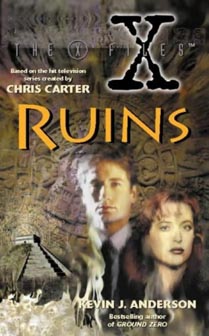Just as Kevin J. Anderson’s “Ground Zero” was a step up from Charles Grant’s books, Anderson’s “Ruins” (1996) is a step up from “Ground Zero.” Unlike his first book, I didn’t know precisely where the story was going this time around, and that made it a more enjoyable read. (Spoilers follow.)
Once again, Anderson gives us “X-Files” on steroids. Rather than mere investigators who don’t get their suits rumpled, Mulder and Scully are full-on adventurers, enduring a multi-day trek through the jungles of Quintana Roo. As their quest begins in the tourist town of Cancun, Scully notes that this case sure beats a remote outpost in Alaska (“Ice”) or a chicken-processing plant in Arkansas (“Our Town”). Later, she longs for Alaska or Arkansas.
The FBI agents are on this rare out-of-country adventure as legal attaches to Mexico as they search for a team of missing UC-San Diego archeology students. “Ruins” is one of the rare “X-Files” yarns to take place outside the U.S. The others are sweeps-week episodes such as “End Game” or “Tunguska”; and the first blockbuster movie, which took the agents to Antarctica. The standalone episode “Dod Kalm,” set in the North Atlantic, also comes to mind.
Anderson understands that since books have an unlimited “budget,” he might as well come up with a big story. Indeed, the climactic scene is reminiscent of “Fight the Future,” which would hit theaters two years later. I haven’t heard that Chris Carter and company cribbed from “Ruins,” but if they did, I wouldn’t be surprised. In the movie, Mulder rescues Scully from a suspended animation pod – and she’s covered with goo – aboard an alien craft, which then takes off. In “Ruins,” Mulder rescues archeologist Cassandra Rubicon from a gooey suspended-animation field, which the aliens use for long journeys across the stars.
Another ship comes along and unleashes its energy beams – I picture “Patient X”/“The Red and the Black” or the movie “Independence Day.” It doesn’t use the beams to abduct or kill anyone, but rather to excavate the ship that had Mayan pyramids – the ancient city of Xitaclan — built atop it. Then it essentially tows that ship out into the stars. As with the movie, Mulder sees everything, but Scully does not. She’s in her camping tent during the book’s scene, and Cassandra is also temporarily blinded from her ordeal. (In the book, Scully actually does see a feathered serpent in the jungle along with Mulder, but by the time she writes up her report, she has rationalized it as an uncatalogued terrestrial species.)
Anderson peppers “Ruins” with lots of juicy mysteries and good payoffs. The discovery of the corpses of Cassandra’s fellow archeologists in a sacrificial well is deliciously creepy stuff, as is Scully’s task of fetching the bodies in order to perform autopsies. The author also teases the idea of the Mayans’ skills with mathematics and science coming from alien teachings, and – although he couldn’t have known it at the time – the introduction of the Mayans into “X-Files” mythology ties in with the date of alien colonization being Dec. 21, 2012, the last day of the Mayan calendar.

Anderson also teases the idea that the Syndicate sent a covert U.S. military team to destroy Xitaclan on the grounds of it being an enemy military base. (The covert team is like a hammer that sees everything as a nail; the soldiers don’t ask questions, they just carry out their mission.) This ties in with the notion that the Syndicate is split into those who want to fight the alien colonists and those who want to appease them.
As he did in “Ground Zero,” the author creates big and broad supporting characters, from the agents’ guide, Aguilar, who is like a slick used-car salesman, to Cassandra’s father Vladamir, who is an endless fount of architectural knowledge and tales. Anderson plays it safe with Mulder and Scully, as this book doesn’t feature substantial revelations such as “Ground Zero’s” reveal that Scully briefly attended Cal-Berkeley and has a particular dislike of nuclear weapons.
One nice moment finds Mulder telling Scully that he appreciates her skeptical but fair analysis of his theories (p. 181). It’s tame compared to the fan-favorite Conversation on the Rock scene from Season 3’s “Quagmire,” which came out just before this book’s release, where Scully mildly attacks Mulder’s obsessions. If you want deep character development of Mulder and Scully, you won’t find it in “Ruins,” but that’s to be expected from a tie-in novel.
While “Ruins” is a rock-solid “X-Files” book, it suffers in comparison to Scott Smith’s “The Ruins” (2006), which features a similar rescue plot and is also set in the Yucatan, and Douglas Preston’s “The Codex” (2004), also about jungle adventures and Mayan artifacts, although that one is set in Honduras. But Smith’s effort is flat-out my favorite horror adventure novel – and Smith spends years crafting his novels, whereas Anderson cranks them out pulp-style – and Preston is one of my favorite authors overall, so I’ll forgive Anderson for not achieving quite the same level. As an “X-Files” tie-in novel, though, “Ruins” is a decent page-turner.

